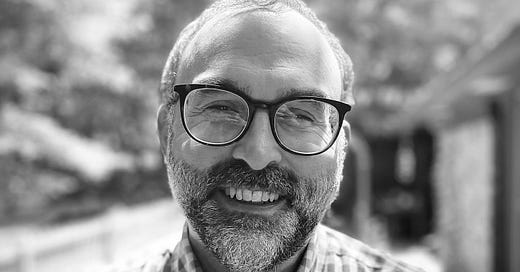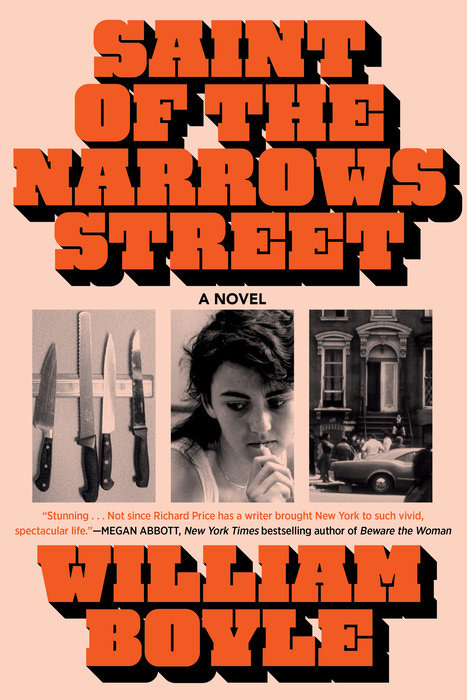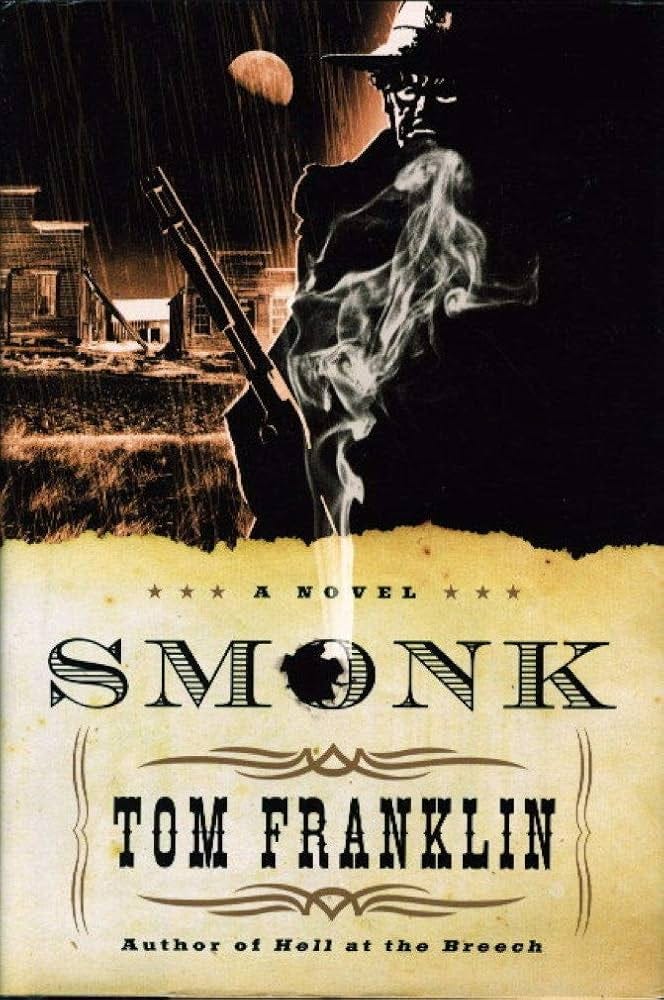#29: Five for Them, One for Me, with William Boyle
Bill's latest, SAINT OF THE NARROWS STREET, is out February 4.
Going into SAINT OF THE NARROWS STREET—the latest from William Boyle—I already expected to love the book. I couldn’t have expected it would so quickly turn into what is already one of my favorite books of the year.
Opening in 1986, the novel chronicles the lives of sisters Risa and Giulia after Risa accidentally kills her no-good husband Saverio with a cast-iron pot. When they decide to cover up the death, Saverio’s childhood Chooch in drawn into their plan, and the book explores the ramifications of this event across the next 18 years.
SAINT OF THE NARROWS STREET contains all of Bill’s trademarks: a knowing and vivid picture of his native Brooklyn; a kaleidoscope of rich and fascinating characters; and beautifully crafted prose and dialogue. It’s noir that never forgets its heart, and Bill gives each wonderfully-named character a wellspring of humanity that makes you root for their meager wins, and ache for them even more in their tragic losses.
Bill’s also the latest Five for Them, One for Me.
Let’s go.
FIVE FOR THEM
1. What was the origin point for your new novel SAINT OF THE NARROWS STREET?
Walking through my neighborhood a few years back, I was remembering a legendary heavy metal club on Sixty-Second Street called L’Amour (“the Rock Capital of Brooklyn,” pronounced by patrons as “La-Morz”). I had an image of two metalhead friends from the same block attending a show there on a hot summer night in August 1986. From there, I unraveled the threads of their lives, going back to the block they were from, Saint of the Narrows Street. The tension between them as they grew apart. One of them, the one who had gone bad, had a wife, and his friend, the quiet and decent one, secretly loved her. The wife—and her rebellious sister—would become the heart of the story. I love that—how a quick glimpse of these men in this sweaty heavy metal club led me to these two sisters. The book grew and changed from what I initially envisioned—the club itself doesn’t even make an appearance—but I did have the sense that they lived on this block and that the action of the book would almost wholly take place there. My earliest draft of the book was set on that one night in August ’86 and included an even more sprawling cast of characters. It changed drastically after that—instead of being contained to one night, the action of the book is spread across eighteen years, though it does stay close to the block for the most part.
2. SAINT OF THE NARROWS STREET uses one of my favorite storytelling engines—the fallout of an accidental killing—but rather than just follow its immediate aftermath, you chronicle its effects on the characters and the neighborhood over the course of nearly 20 years. It makes the book feel both intimate and epic, while also letting you subvert expectations of both the characters and the situation. What made you use the more expansive timeframe to tell the story? And how important is it for you to push back against those expectations?
Most of the other books I’ve written are set in a compressed timeframe, and I’ve always called myself a coward when it comes to time. I’ve read and loved a ton of books that are set across many years, and I wanted to try it. In terms of thinking about time, I was very influenced by Richard Linklater’s Before Trilogy and Boyhood and Barry Jenkins’s Moonlight—lyrical meditations on aging and time. I thought a lot about Giant—both Edna Ferber’s great novel and the classic film adaptation of it. I’m not tackling the full lives of these characters across eighteen years. In four parts, I drop in on them in moments of crisis and stay with them for a day or a day and a half. I’m glad to hear it had the effect of being both intimate and epic—that’s what I was going for. There are these hyperintense, almost real-time sections, followed by time jumps. The difficult part was not falling into the trap of trying to catch up the reader after each of the jumps.
I’m not ever thinking about expectations. I’m always guided by what I’m interested in exploring, and that’s all rooted in character and place and emotional truth. You must be true to what interests you. As a reader and a viewer, I’m not drawn in by formula. I don’t feel any desire to do things by the book. The fallout of an accidental killing is a classic noir trope—I had Fritz Lang’s Scarlet Street on my mind—but I wanted to build off it in ways that felt unusual. The idea of making this a family saga appealed to me. The idea of having certain narrative deceits and evasions appealed to me. In some ways, it’s structured like a classical tragedy—as so much noir is—but there’s a lot of freedom within that framework for the mysterious and unexpected.
3. Your work focuses on these tight-knit communities and neighborhoods in Brooklyn. Meanwhile, you’ve lived in Oxford, Mississippi, for more than fifteen years. Have you drawn any contrasts or comparisons between community in the South and your native New York?
Even before I moved here, I made those connections. What brought me to Oxford was my love of the writer Larry Brown. I wanted to write about my part of southern Brooklyn the way he’d written about his part of northern Mississippi. When you’re not trying to diagnose a place, when you’re focusing on the lives of people in trouble, there’s always going to be something universal. Voices might be different. Cultural stuff might be different. But family dynamics, relationships, crises, narrowmindedness, yearning, loss, regret, love—those things are the same. There’s also something to the fact that I’m from an end-of-the-line neighborhood in Brooklyn that makes it feel like a small town. People from rural places often picture New York City as Times Square, Central Park, skyscrapers, all that. But there are all these neighborhoods that—despite endless sidewalks and subways and overcrowding—can feel very much like small towns. In this book, I zoom in on one block—everyone in everyone else’s business, gossip, melodrama, the whole nine. There’s way more that these places have in common than people might think.
4. The character names in SAINT OF THE NARROWS STREET are fantastic: Chooch, Double Stevie, Rudy the Greek, Knucks, Widow Marie, and—my favorite—Jane the Stain. They feel vital to creating neighborhood and recreating the time period. How important are these details to the worldbuilding in your books?
Naming is one of the things that made me fall in love with writing. My grandfather wasn’t a reader or a writer, but he had nicknames for everyone. Some of them were simple, some were wild. He pulled them out of the air. Or something he saw in a person reminded him of some other random thing and a name sprung from there. His best friend was Harry the Horse (who got that name because he bet the horses but also because he looked horse-like). My grandfather’s brothers, I’m not even sure I knew their real names—I knew them by what he called them. He never called my grandmother or my mother or me by our names. Everybody on our block had a nickname. That really shaped my imagination. I also loved mobster lore, so that contributed to my love of naming. I grew up in an apartment whose previous tenant was Anthony “Gaspipe” Casso. That’s the stuff I start with. Through naming, I can often find the whole world of the story.
5. A striking thing about SAINT OF THE NARROWS STREET—and much of your other work—is the strength of the female characters. The bond between sisters Risa and Giulia remains unbreakable throughout the book. What is important for male writers to know when writing female characters?
Number one: Don’t be a dipshit. The most important people in my life are women, and I’ve been influenced by countless female artists, but I also learn a ton from male writers about what not to do. That’s instructive. I’ll be reading a perfectly good book by a man, and I’ll get to something about the way he writes a female character that makes me wince. I mark those things down in my mind. Don’t do that. Read women. Watch movies by female filmmakers. Listen to music by women. Listen to what female artists say in interviews. Listen to their advice. I feel lucky that I was shaped by female artists from a young age. Maybe it was something about growing up with a single mother, maybe it was the era, I don’t know exactly, but many of the first artists I connected with in a deep and significant way were women. I was thirteen when I heard Tori Amos’s Little Earthquakes—that opened up new ways of seeing and thinking. I fell in love with the poetry Sylvia Plath and Anne Sexton in high school—I felt like I’d never read anything so raw and honest. Patricia Highsmith’s books, which I got to via film adaptations, were huge. Carson McCullers’s The Heart Is a Lonely Hunter switched my brain. Seeing Jane Campion’s The Piano was a game-changer. Allison Anders’s Gas Food Lodging was another big film for me. Ann Petry’s The Street is my favorite novel. Gena Rowlands is my hero. I never had that thing where I was a guy who only engaged with art by guys. Early on, I was aware I didn’t want to be that way. In college, I took women’s literature classes in large part because I’d never been assigned a book by a woman in grade school or high school. I read Doris Lessing, Adrienne Rich, Wanda Coleman, so many writers I might not have found otherwise. You’ve got to do the work. You can’t just think you know what you’re doing and that it’ll all be fine. It’s a process of constantly listening and learning, correcting course, trying to get at some emotional truth without falling into the traps that come with the oftentimes limited perspective of being a man. Writing characters with rich interior lives is key to that—digging deep on hopes, dreams, regrets.
ONE FOR ME
After more than fifteen years in Mississippi, have you found good Italian food in Oxford? If so, where’s your go-to Italian restaurant?
There’s a place in Oxford called Tarasque Cucina that makes very good pasta. I don’t eat out here a ton—mostly we cook at home—so I’m not that tapped into the food scene. Off the top of my head, Tarasque is the only place I’d go for an Italian(ish) meal. New Orleans is five hours away, and I’ve had great Italian meals there that remind me of home.
WHAT I’M READING
In addition to Bill Boyle, there’s an abundance of outstanding writers who’ve called or now call Oxford, Mississippi home. William Faulkner most famously lived there most of his life, and Barry Hannah (YONDER STANDS YOUR OPHAN) directed the MFA program at the University of Mississippi, where his students included Larry Brown (BIG BAD LOVE, JOE) and Donna Tartt (THE SECRET HISTORY). Current crime-writing Oxford residents include Ace Atkins (DON’T LET THE DEVIL RIDE), Chris Offutt (COUNTRY DARK, THE KILLING HILLS), and Tom Franklin (CROOKED LETTER, CROOKED LETTER).
I am a huge fan of Franklin’s Edgar-winning short story “Poachers,” so I decided to try his 2006 novel SMONK. Set in 1911 in Old Town, Alabama, the picaresque novel focuses on E.O. Smonk, a hell-bent rogue who’s been terrorizing Old Town for a year, and what happens when the citizens attempt to seek a form of justice that ultimately involves Christian Deputies, a 15-year-old prostitute, several acts of horrific vengeance, and Old Town’s own secrets. It’s a wild ride of a book, equally brutally violent and darkly hilarious, written in a style that draws a comparison to Cormac McCarthy’s earlier work, but still feels very much Franklin’s own. I’ll surely be checking out his other works soon.
That’s all we’ve got for now. Thanks for coming. See you next time, and hey, let’s be careful out there.







I've had William Boyle's book only list from the moment I saw the cover... and of course Shoot the Moonlight is on my shelves, next to Chris Offutt, happenstance....